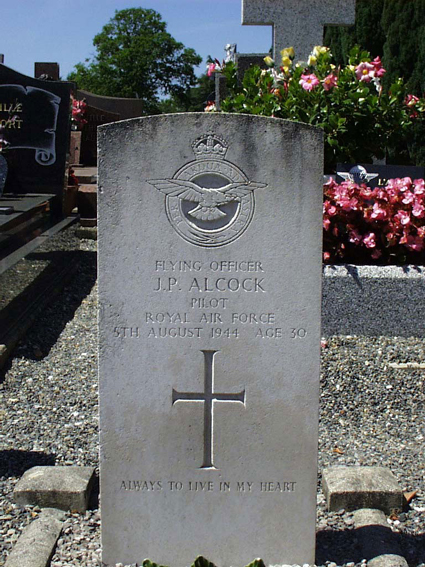|
Royal Air Force Volunteer Reserve Voir commémoration |
|
Jack Alcock transferred to the Royal Air Force from the British Army (Military Police) in 1941. On completing his elementary flight training at 4.E.F.T.S at Brough near Hull in Yorkshire, England he was then transferred to Moncton, New Brunswick, Canada.
No.161 Squadron of the Royal Air Force was a special duties squadron that carried out landings, mainly in France, ferrying secret agents to and from the Continent on their intelligence and sabotage tasks for the Special Operations Executive (SOE). The Lysander landings were carried out in farmer's fields. Agents, trained in Britain for the task, carefully selected the fields to be used which were then photographed from the air and approved for use by the RAF. The only markings of the flarepath were three torches, held by assistants in the field and located to form an inverted L. The flarepath layout is detailed in appendix `J'.
F/O Alcock was posted to No. 161 Squadron, based in Tempsford, Bedfordshire from No.631 Squadron, based in RAF Towyn, Wales with effect from March 20th 19442. The following is a summary of F/O Alcock's operational duties with No. 161 Squadron. His first operational sortie was Operation ORGANIST, a double Lysander sortie to a target field in France, on the evening of 30th April 1944. The two pilots involved in Operation ORGANIST were: F/O J.P. Alcock flying Westland Lysander IIIa V9748: JR-D3 and F/Lt R. Large flying Westland Lysander IIIa V9490: JR-N4. Both planes departed RAF Tangmere at 22.30 hours5.
RAF Tangmere, about four miles east of Chichester, Sussex, was used by No.161 Squadron as a forward base during the moon periods because it was so much nearer to their target areas in France than Tempsford.
RAF Tempsford in 1942, vue aérienne
On board F/O Alcock's plane were two agents and one package6. On board F/Lt Large's plane were one agent and five packages6.
The target field in France, code named HERCULE, for both planes was 13.5 Km SSW of Chateauroux, 4.25 Km W of Arthon, in the district of Indre. The alternate feld, code named FORTUNE, was 15 Km SSW of Chateauroux, 5.5 Km W of Arthon. Special instructions for the Operation stated that the Flare path was to be laid on Fortune if wind direction was unsuitable for Hercule. The reception committee was due to stand by at the target field between 22.30 hours and 01.30 hours. Recognition letter: Air to Ground: AD Ground to Air: BN 7. F/L Large made the first landing on the target field at 01.358. F/O Alcock landed at the target field at 01.458.
F/O Alcock's passengers on the return trip were Philippe Liewer (Charles Staunton)9 and a second agent, naine unknown6. F/L Large's passenger on the return trip was Violette Szabo Liewer and SzaboViolette Szabo10 were SOE agents who had gone to France on the night of April 5'h 1944 being parachuted from a Consolidated B-24D Liberator bomber from the USAAF base at Harrington in Northhamptonshire that had flown to Tempsford Airfield to pick them up. On the return journey both Lysanders came under fire from the ground near Chateaudun.
One of the tires on F/L Large's aircraft was punctured by flak which caused it to ground loop as it landed at Tempsford.
Alcock's propeller was holed, but no injuries were reported11. F/L Large landed at Tempsford at 05.05 F/O Alcock landed at Tempsford at 05.1012.
RAF Tempsford, vue aérienne 1943 Both Philippe Liewer and Violette Szabo were considerable figures in the history of the Resistance10 and both returned to France in June 1944, again parachuting, this time from U.S.A.A.F. B24-D Liberator, 42-40538K, from Harrington that had picked them up in Tempsford. The dropping zone was in the vicinity of the village of Sussac, thirty miles to the south-east of Limoges13. The Germans captured Violette Szabo a few days after she arrived in France as she and other agents approached the village of Salon-la-Tour14. Violette was executed at Ravensbruck Concentration Camp in January 1945 together with SOE agents Denise Bloch and Lilian Rolfe15.
The Lysander `A' Flight including F/O Alcock & eight other pilots departed from Tempsford, Bedfordshire on July 29th 1944 at 10.30 hours and flew to RAF Winkleigh, Devon 16 where they arrived at 14.0017. RAF Winkleigh, near Exeter, was used as a forward base for operations during the August 1944 moon period. Tangmere, the normal forward base, was too close to the Normandy Beach-head and the area of France already liberated18. There was only one Lysander operation between D-Day and the Winkleigh, operation PALAIS19.
F/O Alcock's second operation was Operation PIROGUE, a double Lysander sortie to a target field in France on the evening of 4th August 1944.
F/O J.P. Alcock flying Westland Lysander IIIa V9748 : JR-D20. and F/L Peter Arkell flying Westland Lysander IIIa V....: JR-N21. Both planes departed RAF Winkleigh, Devon at 2100 hours, 4th August 1944. On board F/O Alcock's plane was French Resistance Agent Lucien Germereau of Réseau Écarlate(Scarlet Network)22. Later that evening, at 2150 hours, a RCAF Mosquito night fighter from No. 410 Squadron took off from RAF Colerne in Wiltshire and was directed to a target over France by Tailcoat G.C.I.(Radar system operating in Britain).
F/O Alcock's plane exploded and crashed in flames near a farm called La Patouillais approximately one kilometer from the town of Messac, Ile et Vilaine, Brittany, France. F/O Alcock and his passenger were killed. In his report F/L Dinsdale stated that he had great difficulty in identifying the aircraft he had intercepted; he did note that it carried a long range fuel tank between undercarriages but he could see no national markings23. The tags he was wearing, one red, and one green, inscribed "R.A.F. 127192 F/O J.P. Alcock, 2A R.C.", identified F/O Alcock. His funeral took place 24 the next day at 6.30pm, Saturday August 6h 1944ANNOTATIONS, at Messac's Parish Church24. The documents he was carrying identified Agent Lucien Germerau as Lucien Pradier, this being his cover name and he was buried next to Jack as Lucien Pradier. F/L Arkell, flying some distance behind F/O Alcock, saw a ball of fire in the night sky ahead of him and was told upon landing at the target field that F/O Alcock had not arrived26. F/L Arkell landed on the target field at 02.30 hours returning safely to Winkleigh with two men, Claude Thierry-Mieg and Leon Dupont21, and a girl, name unknown, and 5 packages, landing at 05.5020 hours August 5.
On the night Jack Alcock was killed, a total of five Lysanders left Winkleigh for various destinations in France and all the aircraft, except Jack's, returned safely to Winkleigh. The next night, 5/6th August, two more Lysander operations were undertaken and one Lysander landed on the exact same field in Vatan that F/L Arkell had landed on the night before. On the night of 7/8th August the last Lysander operation from England to France was undertaken, that was Operation GENISTA which failed due to bad visibility. Other special duties aircraft were shot down by our own night fighters. On the night of 20/21th March 1945, for example, three Hudsons were shot down over France by our night fighters, prompting the remark from Hugh Verity, in his book We landed by Moonlight, "There is some doubt which side they were on."
It is not known who made the initial connection between the Mosquito pilot's report and the loss of the Lysander. What is known is that a Court of Inquiry was held and as a result of that Inquiry the claim made by the Mosquito Pilot was not administered. It is also known that entries in both No.161 Squadron and No.410 Squadron Operational Record Books point to the Lysander having been shot down by the Mosquito. I asked F/L Peter Arkell if he could shed any light on the Mosquito story, but his only comment was that it was a dark night and all he saw was a ball of fire in the night sky ahead of him.
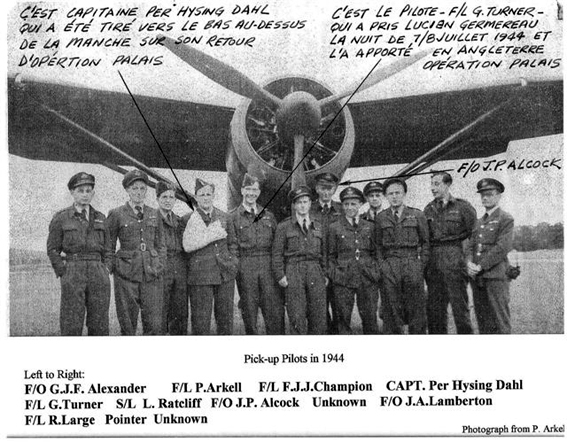
|
|
Jack married Dosie Margaret Harper of Stevenage, Hertfordshire, the daughter of George Edward Harper and Millicent Harper (nee Munson) of Crofton Cottage, Stevenage, Hertfordshire. They were married the 30th November 1942 at the Holy Trinity Church, Paddington, London in the County of Middlesex. Jack gave his address as 8 Colville Gardens, London W 11. At the time of their marriage Jack was twenty nine years of age and Margaret was twenty three years of age29. Margaret was born on the 23rd May 1919 at the home of her parents, 20 Grove Road Stevenage, Hertfordshire30. On December 2rd 1943 Margaret gave birth to their only child, a daughter Carolyn Margaret at the Burslow Nursing Home in Hitchen, Hertfordshire31. Some months later Carolyn developed Eczema and was eventually taken to the Queen Elizabeth Hospital in Bayford, Hertfordshire where she died on the 17th July 1944. The cause of death was given as Bronchia pneumonia and Infantile Eczema32. Carolyn was buried in the graveyard of St Nicholas Church in Old Stevenage, Hertfordshire. The death of Carolyn was registered by Jack on the 18`" July 1944 at Hitchin, Hertfordshire.
Upon having successfully completed his flight training, Jack received his wings on the 5th August 1942 and was commissioned as a Pilot Officer with effect from that date. The date of Gazette for his promotion was 27th October 1942. Jack returned to England on the Cunard Liner Queen Mary. His service record shows he was at No.3 Personnel Reception Centre in Bournemouth with effect from 8th September 1942 and stayed there until 29th September 1942 ; at which time he was posted to No 5 (Pilots) Advance Flying Unit at Ternhill, Shropshire for further flight training.
No.1601, No.1606 and No.1626 Flights were all based at Bodorgan on the Island of Anglesey, Wales. This station was originally named Aberffraw but after further developments to the station had been carried out in 1941, it was renamed Bodorgan. These Flights came under the command of No. 70 Group - Army Co-op Command and provided target towing services for the anti-aircraft gunnery training range at Ty-Croes on the west coast of Anglesey. Planes used for this purpose were Lysanders, Henleys and Martinets. During the time spent at Bodorgan airfield, Jack and Margaret lived in Malltraith, a small village not far from the airfield.
On 1st December 1943 Jack was posted to No. 695 squadron based at Bircham Newton in Norfolk, England. On the 9t" January 1944 he arrived in RAF Towyn, Wales having been posted to No. 631 Squadron with effect from 12th January 1944.
Margaret moved with their baby to Towyn to be with him. On the 14th March of that year he proceeded to Farnborough, Surrey for a navigation course and with effect of 20th March 1944 he was posted to No. 161 Squadron in Tempsford.
Lucien Guermereau
When found in the wreckage of the LysanderANNOTATIONS, Lucien was carrying identity card number 316 issued on the 28t" September 1943 to a Lucien Pradier by the Mayor of Honfleur in which his date of birth was given as 19th June 1907. The identity card also gave the place of birth as Cherbourg, living at 13 Plas due Marche, Honfleur and later at 73 rue de Vanueller at Caen. From inquires made by the Rector of Messac no one of that name was known at Cherbourg and it was assumed by the Rector that Pradier was the cover name used by Germereau in his work for the French Resistance. Lucien was buried in the grave next to F/O Alcock,25.
to Margaret Alcock
-1945
When you come to Messac
............and go to the hotel. It is ?????
............which is necessary to descend, at the
house you will be welcome as much as
possible.
Enclosed are three
photographs of your husbands grave, it has not been
possible to obtain better because the wall of the
cemetery was an obstruction to having the necessary
room. To the right of a fir tree you will find the
grave. There are flowers, a cross of wood & on
this ????? a cross in Black... ......... At the top
of the wooden cross there is a little plaque with
the name of the departed.
On the left of the
photo is the cross of the grave in which lies a
Frenchman named Pradier who was found in your
husband's plane.
Here are some
instructions (details) regarding Pradier. His
identity card number was 316, issued on the 28/9/43
by the mayor of Honfleur in the name of Pradier,
Lucien, born on the 19/6/07 at Cherbourg, living at
13 Plas due Marche, Honfleur, afterwards at 73 rue
de Vanueller at Caen. From inquiries made this name
is unknown at Cherbourg, from which I conclude that
the name was a borrowed one.
Will you have the
kindness of thanking Madame Edith O'Rafferty who
kindly sent some coffee which we appreciated very
much.
I assure you that any
news that I may have is at your disposal and I ask
you to accept, Madame, my respectful
homage.
Leon Rose Rector of
Messac
Reproduction of Newspaper article concerning the death of F/O Alcock that appeared in the Banbury Guardian Newspaper in March 1945
The Late Flight/Officer J.P. Alcock
The following is a copy of a translated letter received from the Archbishop of Rennes through Mons. Massigli, French Ambassador to the Court of St. James', London:"An aerial combat took place over the town of Messac in the department of Ilet Vilaine during the night of August 4/5, 1944. A British machine was shot down by his adversary or by fire from German soldiers, it caught fire and crashed near a farm called La Patouillais, about a kilometer away from the town. The carbonized officer was found. He was wearing two discs, one red, one green, inscribed "R.A.F. 127192 F/O J.P. Alcock, 2A R.C." "The following Saturday at 6.30 p.m. a coffin containing the remains of the officer was carried to the Parish Church, where the religious obsequies took place before a considerable number of people who felt bound thus to show their sympathy to the country and the family of this gallant officer `fallen from the skies." F/O J.P. Alcock lies in the cemetery of Messac and his tomb is frequently covered with flowers. The following is a copy of a letter received from the French Ambassador :- "The above letter has just reached me from the Archbishop of Rennes concerning the death of your son, F/O John Perry Alcock. I should like to express to you my heartfelt sympathy in your sad loss. I trust it will be of some comfort to you to know that he reposes among friends who reverently pay the homage due to a gallant Airman and Ally."
Large a thank you with Tom O' Rafferty, Ontario, Canada for the excellent biography on his/her uncle, John Perry Alcock Source/documents of Tom O' Rafferty |

 From
Moncton he proceeded by train to Alabama U.S.A. for advanced
flight training at various locations including Maxwell and
Gunter fields in Montgomery and Craig Field in
Selma
From
Moncton he proceeded by train to Alabama U.S.A. for advanced
flight training at various locations including Maxwell and
Gunter fields in Montgomery and Craig Field in
Selma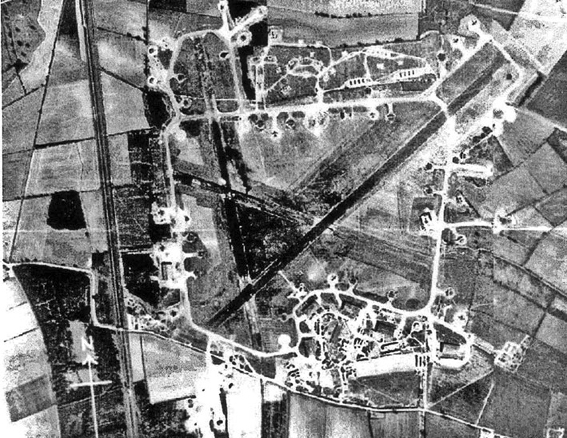
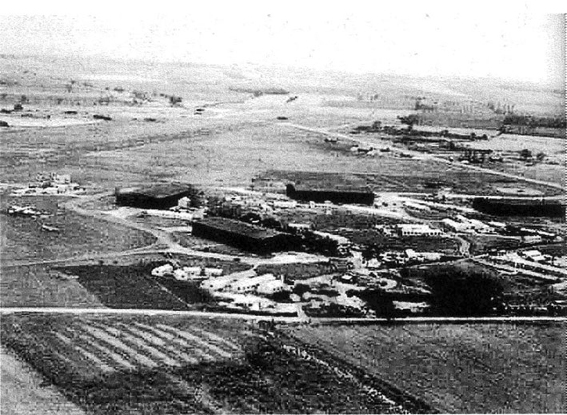
 The
two pilots involved in this operation were :
The
two pilots involved in this operation were :
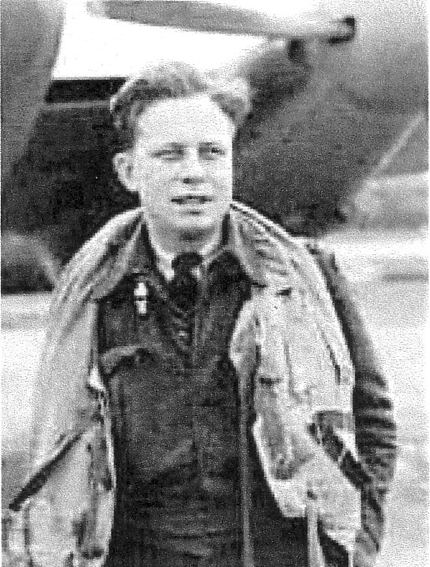

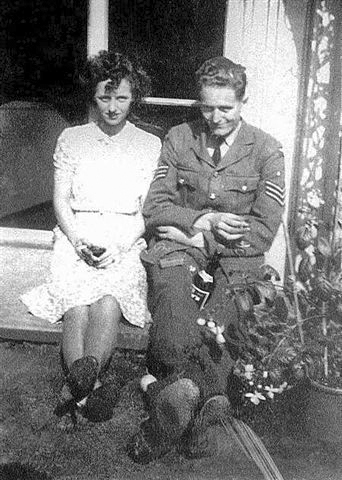 John
Perry (Jack) Alcock was the only son of John James Alcock
and Jemima Elten Alcock (nee Reedy)
John
Perry (Jack) Alcock was the only son of John James Alcock
and Jemima Elten Alcock (nee Reedy)
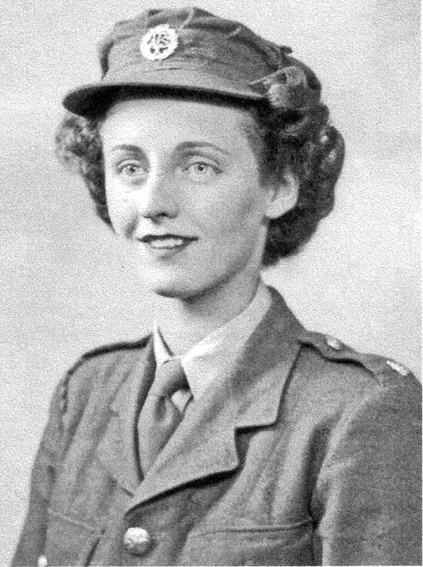
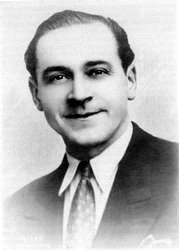 Lucien
Germerau, a French Resistance Agent, was with F/O Alcock
when their Lysander was shot down. Lucien was the Director
of the Chateauroux sector of the Réseau
ÉCARLATE (Scarlet network) and was returning to
France after a visit to London
Lucien
Germerau, a French Resistance Agent, was with F/O Alcock
when their Lysander was shot down. Lucien was the Director
of the Chateauroux sector of the Réseau
ÉCARLATE (Scarlet network) and was returning to
France after a visit to London